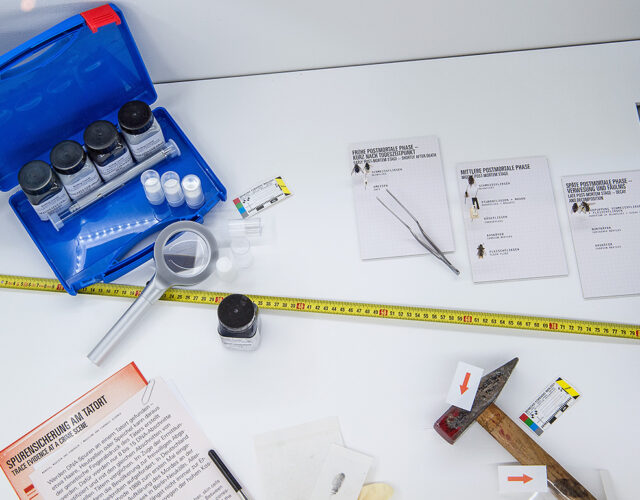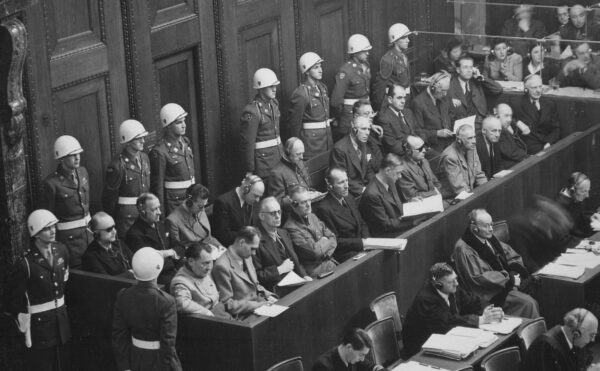Genetic genealogy can catch brutal killers. It can also unmask affairs, secret adoptions, and other dark secrets. As well as expose you—yes, you—to the unholy alliance of Big Tech and shady police work.
The Science History Institute has teamed up with New York Times best-selling author Sam Kean to bring a second history of science podcast to our listeners. The Disappearing Spoon tells little-known stories from our scientific past—from the shocking way the smallpox vaccine was transported around the world to why we don’t have a birth control pill for men. These topsy-turvy science tales, some of which have never made it into history books, are surprisingly powerful and insightful.
Credits
Host: Sam Kean
Senior Producer: Mariel Carr
Producer: Rigoberto Hernandez
Audio Engineer: Jonathan Pfeffer
Transcript
Before I start, a content warning: this episode contains disturbing and graphic descriptions of violence.
The undercover cop slumped down in his seat, trying to hide his face. What was his mark doing?
He’d been following the suspected killer all week. He was waiting for the man to discard some trash so the police could get DNA from it. But the killer was compulsively neat. He never dropped a napkin, a piece of gum, anything. Like he knew he was being watched.
Now, at a red light, the suspect got out of his truck in the middle of traffic. Was he going to run? Confront the people tailing him? The cop slumped down, cringing in worry.
But no. The suspect just fiddled with his seat, as if fixing it. When the light changed, someone honked and he jumped back into his truck. And that’s when it happened. In his hurry, the suspect knocked a coffee cup onto the road—and drove off.
The undercover cop threw his car into park and flung the door open, darting into traffic. He had to get that cup. Cars zoomed by, as the cup flew this way and that, rolling beneath their wheels. One stray swerve could crunch and destroy it—or destroy him. But kept playing human Frogger, dodging and feinting.
And a minute later—he snagged the cup. A minute after that, he reached the side of the road, panting. It was the biggest coup of the young officer’s career.
But it was also a seminal moment in law enforcement history—and not necessarily in a good way. Because that cup, and the wisps of DNA clinging to it, were about to ignite a furious debate about genetic privacy, a debate that would soon ensnare virtually every single person in the country.
Including you, dear listener. Whether you like it or not, that coffee cup would soon expose not just a killer’s DNA, but your DNA, to high-tech police scrutiny.
The case started in November 1987. A man scavenging for bottles in Washington state found 18-year-old Tanya Van Cuylenborg dead in a field beside a rural road. She was half-naked, and had been shot, execution-style, in the head.
A few days later, a hunter found 21-year-old Jay Cook sixty miles north, beneath a bridge. He’d been bludgeoned with a rock and suffocated with a pack of cigarettes shoved down his throat.
Jay and Tanya were a young couple from Vancouver, on their first road trip together. The details remain murky, but at some point while driving down to Seattle, they took a wrong turn, got lost, and ended up murdered. Police later found their things dumped behind a bar near the Canadian border. The van they’d driven was parked a block away.
Unfortunately, the hunt for the killer turned up zero witnesses. And there was zero physical evidence that the police could tie to any suspects.
The only clue was the killer’s semen, which was found on Tanya. Unfortunately, despite what you might have seen in movies, DNA by itself is useless. To find a killer, you have to match DNA to someone in a crime database. And when the police tried to match the DNA from the semen, no names popped up. A dead end.
Needing help, the police turned to the FBI, then the Canadian Mounties and Interpol. All of them failed, too. The case quickly turned cold.
Over the next few decades, as DNA sequencing took off, the databases of crime suspects kept getting bigger and bigger. They eventually encompassed a million people. And cops in Washington state kept dutifully checking the databases to try and match the killer’s DNA. But they kept coming up empty. It was beyond frustrating. They had the killer’s DNA—his essence. But they had no idea who he was.
Meanwhile, a seemingly unrelated development would soon provide a huge clue—the rise of genetic genealogy.
Traditionally, genealogists build family trees through paper records: Census data, birth certificates, obituaries, stuff like that. It’s dusty history, focused on documents.
Genetic genealogists build family trees through DNA. We all share DNA with our relatives. You share the most with your parents and siblings. Then first cousins, second cousins, and so on. You can therefore look at two people’s DNA, and tell exactly how related they are. Genealogists love this. They can find long-lost cousins all over the world.
One prominent genetic genealogist is CeCe Moore. In the early 2000s, Moore was acting in Los Angeles in TV commercials and musicals. She also played Barbie at toy-store openings, because she had big blonde hair.
Moore first got into genealogy while making a family tree for her niece as an engagement gift. Moore quickly got hooked, and eventually quit acting to pursue genealogy full-time. She especially enjoyed genetic genealogy—high-tech meets antiquarian.
But she also ran smack into the downsides of genetic genealogy. Her brother-in-law always told everyone he was part American Indian, because his parents told him so. He asked Moore to help him learn more.
Cringingly, Moore found he wasn’t actually Indian. He did have Black ancestry, and was in fact descended from Thomas Jefferson and Sally Hemings. Which was interesting, to be descended from historical figures. But the discovery also threw the brother-in-law for a loop. He’d always thought of himself as Indian—it was part of his identity. But now what? Who was he?
And he wasn’t alone. Genetic genealogy can unearth all sorts of bad surprises—illicit affairs, secret adoptions, babies switched at birth. It sounds like soap opera stuff. But DNA genealogy has exposed all of those things and more. Genealogists call such discoveries N-P-Es, for non-parental events. NPEs can tear families apart. And they’re not that rare. Up to 2 percent of the population was not raised by their biological parents.
Now, for all the scandals it unearthed, genetic genealogy seemed to have little to do with police work. That’s because police use DNA differently than genealogists do. Police use DNA exclude people. They might have five suspects and want to rule four out. Or they use a database to zero in on one person.
Genealogists do the opposite. They cast a wide net to capture as many people as possible—all your relatives. And at first, that wide net might seem useless for criminal investigations, where you don’t need more suspects, you need fewer.
But CeCe Moore and a few other savvy genealogists realized something—something crucial. Again, police look for exact matches to a killer’s DNA. But you can also look for partial DNA matches using genetic genealogy—and thereby find the killer’s relatives. That’s obviously a huge clue.
Now, I should point out that these genealogist-detectives are not using commercial DNA sites like 23andMe or Ancestry.com. Those sites are private, with strict controls over access. Genealogists use open, public databases like GEDmatch. With those databases, people voluntarily upload their DNA in the hopes that relatives will do the same and they can get in touch.
But because the databases are public, genealogists can use them, too. To find a killer, they simply upload his DNA, then search for partial matches. Those are relatives. Based on the percentage of DNA in common, genealogists can tell how closely related the killer is. From there, they can use obituaries, Census records, and birth certificates to piece together a family tree and find the killer himself.
You might have heard about this method being used in 2018 to nail the Golden State Killer, who raped and killed dozens of women in California starting in 1974. The case made big headlines—a serial killer nailed by fusty genealogists. It sounded like an Agatha Christie plot.
But most observers thought the Golden State Killer case was an anomaly. The head genealogist spent four months hunting the killer down, and hundreds of people overall put in time. It was considered a “moonshot” effort—undertaken in desperation to nail one notorious killer. Local police departments couldn’t repeat that effort for every cold case.
Or could they?
The detective in charge of Jay Cook and Tanya van Cuylenburg’s murders was Jim Scharf. As a cold case detective, he had a good track record: he’d cracked eight other unsolved murders. But he’d rarely seen a case with so little evidence. He was desperate. So after hearing about the Golden State case, Scharf reached out to a genetics company that CeCe Moore worked with.
In May 2018, on a phone call, the company’s CEO told Scharf that they could probably find some suspects within four days. Scharf just chuckled. The case had been cold 31 years. And they were going to finger new suspects in four days? Sure, right.
And truth be told, Scharf had other reasons to be dubious. The genetics company also built so-called DNA mugshots. That is, they used snippets of DNA to predict suspects’ eye color, hair color, facial shape, and so on.
Now, most cops consider DNA mugshots about on par with palm reading. They’re voodoo. And I have to say, they have a point. In fact, I’ve put together a bonus episode on why I think DNA mugshots are bunk. Check it out at Patreon.com/DisappearingSpoon.
But suffice to say, Scharf was not impressed by the company dabbling in DNA mugshots. And when they promised they’d have suspects in four days, things must have looked even shakier.
But Scharf didn’t know about CeCe Moore. Now, Moore was not involved in the mugshot stuff. She worked strictly on genealogy. And it turned out the CEO’s estimate of four days was way off. Moore did not finger the killer in four days. She did it in two hours.
Moore’s search for the killer started with her identifying two second cousins based on their DNA. Then she pivoted to newspaper archives with obits and birth announcement and built a family tree. Before long, she’d identified the family to which the killer belonged—the only possible family whose children would be second cousins to the matches in the DNA database.
From there, Moore turned to every modern detective’s best friend—Facebook. She found the family, who lived in Washington state. There were four children—but just one male, the only one who could have left semen.
That man was William Earl Talbott II—a loner, a drifter, a 10th-grade dropout. An old address of his was just up the road from where Jay Cook’s body was dumped near the bridge. Moore fired off an email with a single word in the subject line: “solved.”
Detective Jim Scharf was shocked when he got the news—he actually started crying. He still needed to get Talbott’s DNA, to confirm that Moore was right. That led to the scene at the start of this episode, with the undercover cop dodging traffic to snag the coffee cup that Talbott let fall from his truck. But it was worth it. The DNA on the cup was a perfect match with the killer’s. The FBI, the Mounties, Interpol had spent decades on the case. Moore solved it in her sweatpants without leaving her couch.
Again, the Golden State Killer case was the first to use genetic genealogy. And that case was presented as a moonshot—months of work. No one thought they could replicate that effort.
But Moore’s sleuthing completely shifted police thinking. Maybe genetic genealogy didn’t have to be a moonshot. Maybe police could use it all the time.
In fact, as if trying to prove this, Moore kept going after the Talbott case. She took on four more cold cases that the police had spent 126 years on collectively. Moore solved them all in five weeks—two in one day. By end of 2018, she’d nailed 32 suspects, all with leaving her home.
These were staggering figures. And they helped dozens of victims’ families heal. So how did the genetic genealogy community react to Moore’s sleuthing? Many were outraged.
This outrage stemmed from one thing: a commitment to absolute DNA privacy. You see, Moore and the police searched the DNA databases without a search warrant or court order. No judge, no regulatory agency ever weighed in. Furthermore, the people in the DNA databases had never consented to having their DNA used in this way, in police work. This was arguably a huge violation of their privacy.
And not just their privacy. Because, think about it. Let’s say a few of your second cousins—people you’ve maybe never met—upload their DNA to one of these databases. Well, they’re effectively uploading your DNA as well, because of the overlaps. And given the size of the biggest databases, statistically, if you live in the U.S. or have relatives here, swaths of your DNA are already public. DNA that can expose adoptions, affairs, or private medical conditions. Do you really want the cops knowing all that?
There are also profound concerns about gathering DNA without warrants. Every time you throw away a napkin or tissue, or even lose a strand of hair, there goes your DNA. By legal precedent, trash is considered fair game for cops to collect. In legal jargon, there’s no expectation of privacy when it comes to trash. But is DNA really the same as regular trash? Arguably DNA is the single most private thing about you. So does the police digging through your DNA violate your right to privacy?
This is all the more fraught because most of police officers using the genetic information have zero scientific training. That makes it all too easy to jump to wrong conclusions and accuse innocent people of crimes. Which has happened. Two major trends in our society over the past decade have been increasing skepticism of police and increasing skepticism of Big Tech. Genetic genealogy might represent an unholy alliance of the two.
But, then again, opposing genetic detective work means, effectively, thwarting investigations to find brutal killers. It can also throw up roadblocks in active investigations.
Consider another case that CeCe Moore worked on. A man in Utah raped a 79-year-old woman and escaped. Police feared he’d strike again. They begged Moore to find him. This case proved tougher to crack than Talbott’s case. Moore spent three straight 18-hour days on her laptop. But she finally hunted the suspect down, and got him off the street. Should absolute genetic privacy outweigh such clear and present danger?
Honestly, I don’t know. I flip back and forth. But this issue is not going away.
Genetic genealogy also helped collar the recent suspect in the Idaho college murders. But in relaying facts to the public, the police deliberately omitted all mention of using genetics. Probably because they know how controversial it is.
Then again, what about the privacy of the distant cousins? They didn’t want to be involved. Some don’t even want to know they’re related to suspected killers. There aren’t easy answers.
Asking whether you favor the use of genetic genealogy in police work is like asking if you favor getting older. That’s the wrong question. It’s going to happen no matter what. It’s more a matter of how to deal with it.
Some people called DNA the “forever witness”, because it’s always there, ready to testify. And it’s true—it is a forever witness. Which means that the questions genetic genealogy raises, about public versus private good, will likely be around forever as well.




